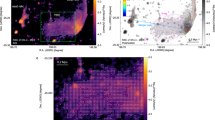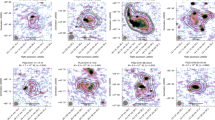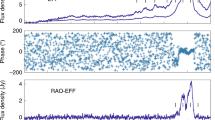Abstract
Galaxy clusters are known to harbour magnetic fields, the nature of which remains unresolved. Intra-cluster magnetic fields can be observed at the density contact discontinuity formed by cool and dense plasma running into hot ambient plasma1,2, and the discontinuity exists3 near the second-brightest galaxy4, MRC 0600-399, in the merging galaxy cluster Abell 3376 (redshift 0.0461). Elongated X-ray emission in the east–west direction shows a comet-like structure that reaches the megaparsec scale5. Previous radio observations6,7 detected the bent jets from MRC 0600-399, moving in same direction as the sub-cluster, against ram pressure. Here we report radio8,9 observations of MRC 0600-399 that have 3.4 and 11 times higher resolution and sensitivity, respectively, than the previous results6. In contrast to typical jets10,11, MRC 0600-399 shows a 90-degree bend at the contact discontinuity, and the collimated jets extend over 100 kiloparsecs from the point of the bend. We see diffuse, elongated emission that we name ‘double-scythe’ structures. The spectral index flattens downstream of the bend point, indicating cosmic-ray reacceleration. High-resolution numerical simulations reveal that the ordered magnetic field along the discontinuity has an important role in the change of jet direction. The morphology of the double-scythe jets is consistent with the simulations. Our results provide insights into the effect of magnetic fields on the evolution of the member galaxies and intra-cluster medium of galaxy clusters.
This is a preview of subscription content, access via your institution
Access options
Access Nature and 54 other Nature Portfolio journals
Get Nature+, our best-value online-access subscription
$29.99 / 30 days
cancel any time
Subscribe to this journal
Receive 51 print issues and online access
$199.00 per year
only $3.90 per issue
Buy this article
- Purchase on Springer Link
- Instant access to full article PDF
Prices may be subject to local taxes which are calculated during checkout




Similar content being viewed by others
Data availability
The raw MeerKAT data used in this work can be accessed at https://archive.sarao.ac.za (project ID: SCI-20190418-JC-01). The calibrated MeerKAT data and images that support the findings of this study are available from the corresponding authors upon reasonable request.
References
Markevitch, M. et al. Chandra observation of Abell 2142: survival of dense subcluster cores in a merger. Astrophys. J. 541, 542–549 (2000).
Vikhlinin, A., Markevitch, M. & Murray, S. S. A moving cold front in the intergalactic medium of A3667. Astrophys. J. 551, 160–171 (2001).
Urdampilleta, I. et al. X-ray study of the double radio relic Abell 3376 with Suzaku. Astron. Astrophys. 618, A74 (2018).
Durret, F. et al. The merging cluster of galaxies Abell 3376: an optical view. Astron. Astrophys. 560, A78 (2013).
Machado, R. E. G. & Lima Neto, G. B. Simulations of the merging galaxy cluster Abell 3376. Mon. Not. R. Astron. Soc. 430, 3249–3260 (2013).
Bagchi, J., Durret, F., Neto, G. B. L. & Paul, S. Giant ringlike radio structures around galaxy cluster Abell 3376. Science 314, 791–794 (2006).
Kale, R. et al. Spectral and polarization study of the double relics in Abell 3376 using the Giant Metrewave Radio Telescope and the Very Large Array. Mon. Not. R. Astron. Soc. 426, 1204–1211 (2012).
Jonas, J. & MeerKAT Team. The MeerKAT radio telescope. In MeerKAT Science: On the Pathway to the SKA, 1 (PoS, 2016).
Mauch, T. et al. The 1.28 GHz MeerKAT DEEP2 image. Astrophys. J. 888, 61 (2020).
Owen, F. N. & Rudnick, L. Radio sources with wide-angle tails in Abell clusters of galaxies. Astrophys. J. Lett. 205, 1–4 (1976).
Jones, T. W. & Owen, F. N. Hot gas in elliptical galaxies and the formation of head-tail radio sources. Astrophys. J. 234, 818–824 (1979).
Markevitch, M. & Vikhlinin, A. Shocks and cold fronts in galaxy clusters. Phys. Rep. 443, 1–53 (2007).
Gunn, J. E., Gott, I. & Richard, J. On the infall of matter into clusters of galaxies and some effects on their evolution. Astrophys. J. 176, 1 (1972).
Donnert, J., Vazza, F., Brüggen, M. & ZuHone, J. magnetic field amplification in galaxy clusters and its simulation. Space Sci. Rev. 214, 122 (2018).
ZuHone, J. A. & Roediger, E. Cold fronts: probes of plasma astrophysics in galaxy clusters. J. Plasma Phys. 82, 535820301 (2016).
Werner, N. et al. Deep Chandra observation and numerical studies of the nearest cluster cold front in the sky. Mon. Not. R. Astron. Soc. 455, 846–858 (2016).
Walker, S. A., ZuHone, J., Fabian, A. & Sanders, J. The split in the ancient cold front in the Perseus cluster. Nat. Astron. 2, 292–296 (2018).
Nolting, C., Jones, T. W., O’Neill, B. J. & Mendygral, P. J. Interactions between radio galaxies and cluster shocks. I. Jet axes aligned with shock normals. Astrophys. J. 876, 154 (2019).
Lal, D. V. NGC 4869 in the Coma cluster: twist, wrap, overlap and bend. Astron. J. 160, 161 (2020).
Takizawa, M. Hydrodynamic simulations of a moving substructure in a cluster of galaxies: cold fronts and turbulence generation. Astrophys. J. 629, 791–796 (2005).
Asai, N., Fukuda, N. & Matsumoto, R. Three-dimensional magnetohydrodynamic simulations of cold fronts in magnetically turbulent ICM. Astrophys. J. 663, 816–823 (2007).
ZuHone, J. A., Markevitch, M. & Lee, D. Sloshing of the magnetized cool gas in the cores of galaxy clusters. Astrophys. J. 743, 16 (2011).
Chen, H., Jones, C., Andrade-Santos, F., ZuHone, J. A. & Li, Z. Gas sloshing in Abell 2204: constraining the properties of the magnetized intracluster medium. Astrophys. J. 838, 38 (2017).
Matsumoto, Y. et al. Magnetohydrodynamic simulation code CANS+: assessments and applications. Publ. Astron. Soc. Jpn 71, 83 (2019).
Hallman, E. J. & Markevitch, M. Chandra observation of the merging cluster A168: a late stage in the evolution of a cold front. Astrophys. J. 610, L81–L84 (2004).
Sheardown, A. et al. A new class of X-ray tails of early-type galaxies and subclusters in galaxy clusters: slingshot tails versus ram pressure stripped tails. Astrophys. J. 874, 112 (2019).
Hickish, J. et al. A Decade of Developing Radio-Astronomy Instrumentation using CASPER Open-Source Technology. J. Astron. Instrum. 5, 1641001–1641012 (2016).
Offringa, A. R., van de Gronde, J. J. & Roerdink, J. B. T. M. A morphological algorithm for improving radio-frequency interference detection. Astron. Astrophys. 539, A95 (2012).
McMullin, J. P., Waters, B., Schiebel, D., Young, W. & Golap, K. CASA architecture and applications. ASP Conf. Ser. 376, 127 (2007).
Offringa, A. R. et al. WSCLEAN: an implementation of a fast, generic wide-field imager for radio astronomy. Mon. Not. R. Astron. Soc. 444, 606–619 (2014).
Kenyon, J. S., Smirnov, O. M., Grobler, T. L. & Perkins, S. J. CUBICAL – fast radio interferometric calibration suite exploiting complex optimization. Mon. Not. R. Astron. Soc. 478, 2399–2415 (2018).
Eckert, D. et al. The gas distribution in the outer regions of galaxy clusters. Astron. Astrophys. 541, A57 (2012).
Wang, Q. H. S., Markevitch, M. & Giacintucci, S. The merging galaxy cluster A520—a broken-up cool core, a dark subcluster, and an X-ray channel. Astrophys. J. 833, 99 (2016).
Koide, S., Sakai, J.-I., Nishikawa, K.-I. & Mutel, R. L. Numerical simulation of bent jets: propogation into an oblique magnetic field. Astrophys. J. 464, 724 (1996).
Rybicki, G. B. and Lightman, A. P. Radiative Processes in Astrophysics (Wiley-VCH, 1985).
Bicknell, G. V., Mukherjee, D., Wagner, A. Y., Sutherland, R. S. & Nesvadba, N. P. H. Relativistic jet feedback – II. Relationship to gigahertz peak spectrum and compact steep spectrum radio galaxies. Mon. Not. R. Astron. Soc. 475, 3493–3501 (2018).
Komarov, S., Reynolds, C. & Churazov, E. Propagation of weak shocks in cool-core galaxy clusters in two-temperature magnetohydrodynamics with anisotropic thermal conduction. Mon. Not. R. Astron. Soc. 497, 1434–1442 (2020).
Cavagnolo, K. W., Donahue, M., Voit, G. M. & Sun, M. Intracluster medium entropy profiles for a Chandra archival sample of galaxy clusters. Astrophys. J. Suppl. Ser. 182, 12–32 (2009).
Tajima, T. & Shibata, K. Plasma Astrophysics (Basic Books, 1997).
Acknowledgements
J.O.C. acknowledges support from the Italian Ministry of Foreign Affairs and International Cooperation (MAECI grant number ZA18GR02) and the South African Department of Science and Technology’s National Research Foundation (DST-NRF grant number 113121) as part of the ISARP RADIOSKY2020 Joint Research Scheme. V.P. acknowledges financial assistance from the South African Radio Astronomy Observatory (SARAO) and the South African Research Chairs Initiative of the Department of Science and Technology and National Research Foundation. This study makes use of MeerKAT data (project ID: SCI-20190418-JC-01). The MeerKAT telescope is operated by the South African Radio Astronomy Observatory, which is a facility of the National Research Foundation, an agency of the Department of Science and Innovation (DSI). SRON is supported financially by NWO, the Netherlands Organization for Scientific Research. Numerical computations and analyses were partially carried out on Cray XC50 and analysis servers, respectively, at the Center for Computational Astrophysics, National Astronomical Observatory of Japan. The computation was carried out using the computer resources at the Research Institute for Information Technology, Kyushu University. This work was supported by JSPS KAKENHI grant numbers 20J13339 (H.S.), 20J12591 (T.O.), 19K03916, 20H01941 (M.M.) and 17H01110 and 19H05076 (T.T.T.). T.T.T. was also supported in part by the Sumitomo Foundation Fiscal 2018 Grant for Basic Science Research Projects (180923) and Collaboration Funding of the Institute of Statistical Mathematics “New Development of the Studies on Galaxy Evolution with a Method of Data Science”. The development of SAOImageDS9 software (https://sites.google.com/cfa.harvard.edu/saoimageds9/about?authuser=0) was made possible by funding from the Chandra X-ray Science Center (CXC), the High Energy Astrophysics Science Archive Center (HEASARC) and the JWST Mission office at the Space Telescope Science Institute. This research used Astropy, a community-developed core Python package for Astronomy.
Author information
Authors and Affiliations
Contributions
J.O.C. conducted the observations and data reduction. V.P. participated in the MeerKAT data reduction, and H.S. analysed the results and processed their implementations. T.O. and M.M. constructed the theory and model and conducted the numerical simulations. H.A. performed X-ray data analysis and wrote the scientific discussion. T.A. contributed to the writing of the MeerKAT proposal and the scientific discussion. T.T.T., R.v.R. and H.N. contributed to the scientific discussions. All authors reviewed the manuscript.
Corresponding authors
Ethics declarations
Competing interests
The authors declare no competing interests.
Additional information
Peer review information Nature thanks Joydeep Bagchi and Maxim Markevitch for their contribution to the peer review of this work. Peer reviewer reports are available.
Publisher’s note Springer Nature remains neutral with regard to jurisdictional claims in published maps and institutional affiliations.
Supplementary information
Rights and permissions
About this article
Cite this article
Chibueze, J.O., Sakemi, H., Ohmura, T. et al. Jets from MRC 0600-399 bent by magnetic fields in the cluster Abell 3376. Nature 593, 47–50 (2021). https://doi.org/10.1038/s41586-021-03434-1
Received:
Accepted:
Published:
Issue Date:
DOI: https://doi.org/10.1038/s41586-021-03434-1
This article is cited by
-
Synchrotron intensity gradient revealing magnetic fields in galaxy clusters
Nature Communications (2024)
-
In-situ acceleration of radio-emitting particles in the lobes of radio galaxies: Evolving observational perspective and recent clues
Journal of Astrophysics and Astronomy (2024)
Comments
By submitting a comment you agree to abide by our Terms and Community Guidelines. If you find something abusive or that does not comply with our terms or guidelines please flag it as inappropriate.



